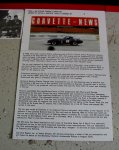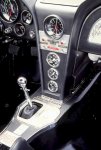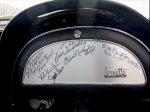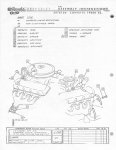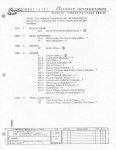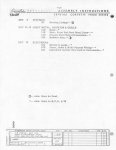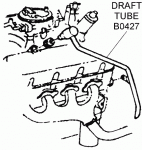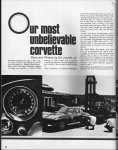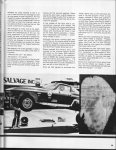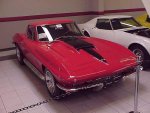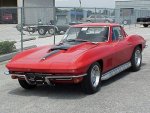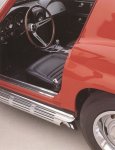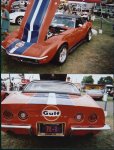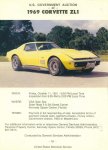67HEAVEN
Well-known user
Many Corvette people will know that the illustrious L88 RPO (Regular Production Option) package was available in 1967-68-69 only. However, a very special COPO (Central Office Production Order) car was built and raced in 1966. It is the first L88, basically a test mule, that was never available to the public. Here it was on display at Corvettes at Carlisle.

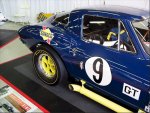
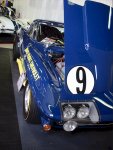

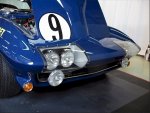
Following Duntov's addition of the new Mark IV big-block engine to the option sheet in 1965 (RPO L78), as a 425hp / 396 c.i., he knew he was on the right course for race wins.
The next step was in 1966, with the release of RPO L72, a 427c.i. / 450hp version of the same big-block. During the model run, insurance company concerns were being noticed, so the chrome air cleaner cover stickers started showing 425hp, rather than 450hp. Identical engine...different stickers. LOL.
Public acceptance of the L72 was so good that Duntov, in his infinite wisdom decided that, in 1967, he would replace the Holley 4bbl carb on the L72 with 3x2bbl Holley carbs (435hp) and call it RPO L71. By 1967, both the L78 and the L72 were gone from the option sheet. But Duntov wasn't finished. Experimental work with aluminum head castings was paying off, so these new heads (RPO L89) became an option on an option in 1967. Yes, you could order RPO code L71/L89 which provided you with a 427 c.i./435hp engine with aluminum heads. Only 16 were sold to the public, making these a truly rare Corvette.
decided that, in 1967, he would replace the Holley 4bbl carb on the L72 with 3x2bbl Holley carbs (435hp) and call it RPO L71. By 1967, both the L78 and the L72 were gone from the option sheet. But Duntov wasn't finished. Experimental work with aluminum head castings was paying off, so these new heads (RPO L89) became an option on an option in 1967. Yes, you could order RPO code L71/L89 which provided you with a 427 c.i./435hp engine with aluminum heads. Only 16 were sold to the public, making these a truly rare Corvette.
Maybe it's time for a brief reminder that there were two flavours of Chevrolet big-block engines in the late '60s. Passenger and Hi-Performance. 'Passenger' engines referred to the garden variety 427 (later 402 and 454) that came with 10.25:1 compression, 2-bolt main block, average size intake and exhaust valves and intake runners, hydraulic lifters and associated medium-performance camshaft, cast iron intake manifolds, typical breaker ignition systems, and the availability of things like air conditioning. Horsepower ratings ranged from RPO L36 390hp (single 4bbl carb) to RPO L68 400hp (3x2 carbs).
If you wanted more performance, you opted for the Hi-Performance versions, such as the previously mentioned RPO L78 in 1965 (396 c.i. with single 4bbl carb and 450hp...later downgraded to 425hp), L72 in 1966 (427 c.i. with single 4bbl carb and 425hp), or L71 in 1967 (3x2bbl carbs and 435hp)...or the L71/L89 (aluminum heads) to save about 80 pounds on the front end of the car. These had the beefier 4-bolt main blocks, 11.0:1 compression and breakerless transistorized ignition. The heads included larger intake and exhaust values, while the intakes were aluminum rather than cast iron and had improved runners and height.
But as always, Duntov wasn't finished. He had the Heavy-Duty engine options ready to spring on an unsuspecting world, which brings us back to the car shown above. The 1966 L88 COPO "mule" would lead to RPO L88 in '67-8-9 and become legendary! How does 12.5:1 compression sound as a starting point?
I intend to add more detail about the L88 and the ZL1 (over in C3) in the near future. Hopefully, I'm not the only one interested in these amazing vehicles of yesteryear. After all, there are so many lesser known amazing developments in the early years, such as the ZR1, ZR2, LT1, LT2, ZL1, LS6, LS7 and on and on.




Following Duntov's addition of the new Mark IV big-block engine to the option sheet in 1965 (RPO L78), as a 425hp / 396 c.i., he knew he was on the right course for race wins.
The next step was in 1966, with the release of RPO L72, a 427c.i. / 450hp version of the same big-block. During the model run, insurance company concerns were being noticed, so the chrome air cleaner cover stickers started showing 425hp, rather than 450hp. Identical engine...different stickers. LOL.
Public acceptance of the L72 was so good that Duntov, in his infinite wisdom
Maybe it's time for a brief reminder that there were two flavours of Chevrolet big-block engines in the late '60s. Passenger and Hi-Performance. 'Passenger' engines referred to the garden variety 427 (later 402 and 454) that came with 10.25:1 compression, 2-bolt main block, average size intake and exhaust valves and intake runners, hydraulic lifters and associated medium-performance camshaft, cast iron intake manifolds, typical breaker ignition systems, and the availability of things like air conditioning. Horsepower ratings ranged from RPO L36 390hp (single 4bbl carb) to RPO L68 400hp (3x2 carbs).
If you wanted more performance, you opted for the Hi-Performance versions, such as the previously mentioned RPO L78 in 1965 (396 c.i. with single 4bbl carb and 450hp...later downgraded to 425hp), L72 in 1966 (427 c.i. with single 4bbl carb and 425hp), or L71 in 1967 (3x2bbl carbs and 435hp)...or the L71/L89 (aluminum heads) to save about 80 pounds on the front end of the car. These had the beefier 4-bolt main blocks, 11.0:1 compression and breakerless transistorized ignition. The heads included larger intake and exhaust values, while the intakes were aluminum rather than cast iron and had improved runners and height.
But as always, Duntov wasn't finished. He had the Heavy-Duty engine options ready to spring on an unsuspecting world, which brings us back to the car shown above. The 1966 L88 COPO "mule" would lead to RPO L88 in '67-8-9 and become legendary! How does 12.5:1 compression sound as a starting point?
I intend to add more detail about the L88 and the ZL1 (over in C3) in the near future. Hopefully, I'm not the only one interested in these amazing vehicles of yesteryear. After all, there are so many lesser known amazing developments in the early years, such as the ZR1, ZR2, LT1, LT2, ZL1, LS6, LS7 and on and on.

Last edited:

